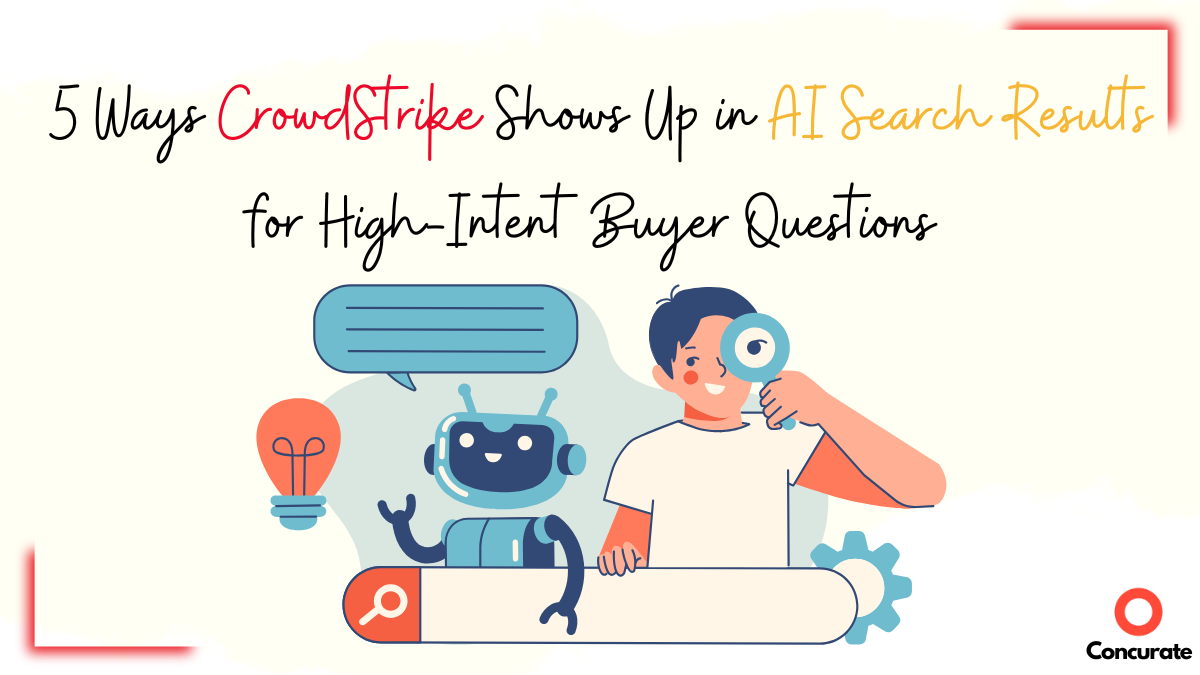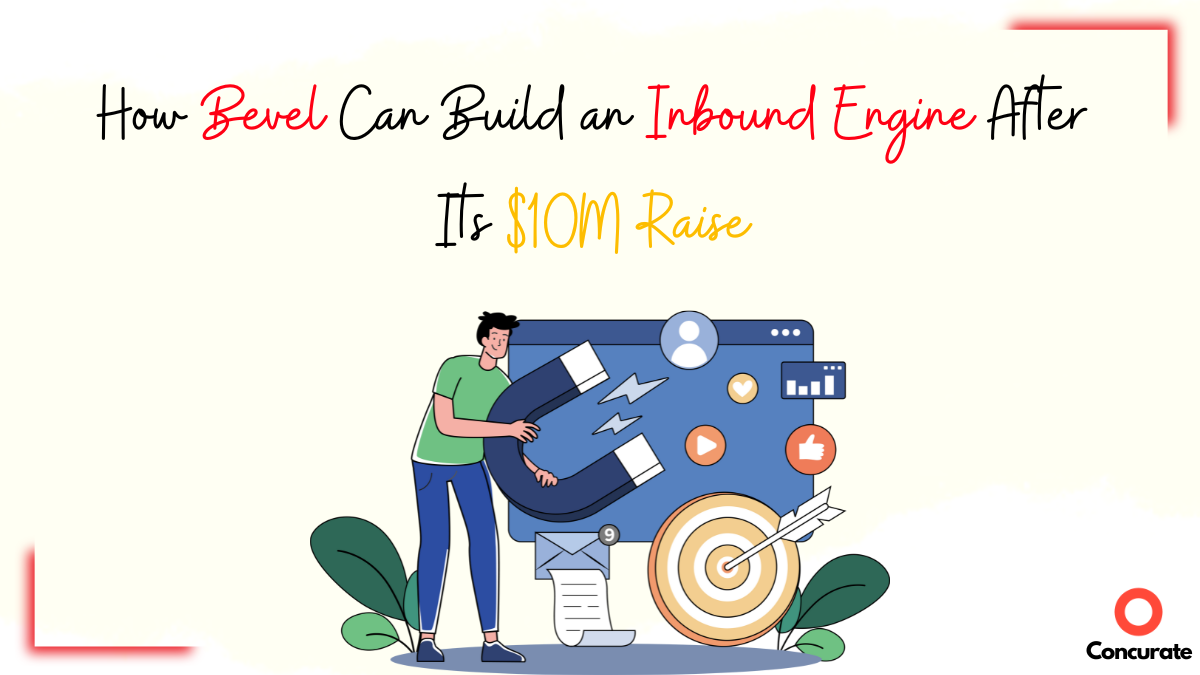| TL;DR: Buyers aren’t just searching Google anymore, they’re asking AI tools what to buy. CrowdStrike shows up because they’ve engineered their content for AI search. This article breaks down 5 strategies they use and what SaaS founders can learn to earn the same visibility. |
Your buyers aren’t just Googling anymore.
They’re asking ChatGPT, Perplexity, and Gemini questions like: “What’s the best cybersecurity platform?”
And CrowdStrike keeps showing up.
Not by accident but by design.
While most companies are still chasing Google rankings, CrowdStrike is already engineering its presence in AI search results.
That means when high-intent buyers ask AI for recommendations, CrowdStrike is in the answer set.
If you run a SaaS company, this matters. Because the way you show up (or don’t) in AI search can decide whether buyers ever even consider you.
Here are 5 ways CrowdStrike ensures AI tools mention them and what you, as a founder, can learn from it.
5 Ways CrowdStrike Shows Up in AI Search Results for High-Intent Buyer Questions
#1 They Answer Buyer Questions Directly
When buyers ask AI tools something like “What’s the best endpoint protection?” or “CrowdStrike vs. SentinelOne – which should I pick?”CrowdStrike already has content waiting.
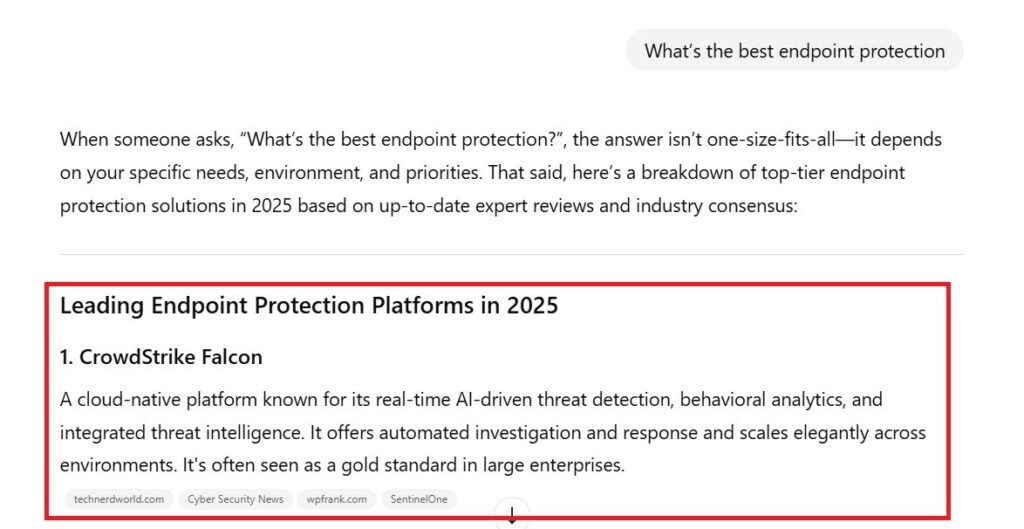
Crowdstike showing as best endpoint protection platform on ChatGPT
They’ve built detailed comparison pages, solution explainers, and use-case content that line up with those exact questions.
So when ChatGPT or Perplexity scans the web to form an answer, CrowdStrike shows up because they’ve done the work of answering buyer intent head-on.
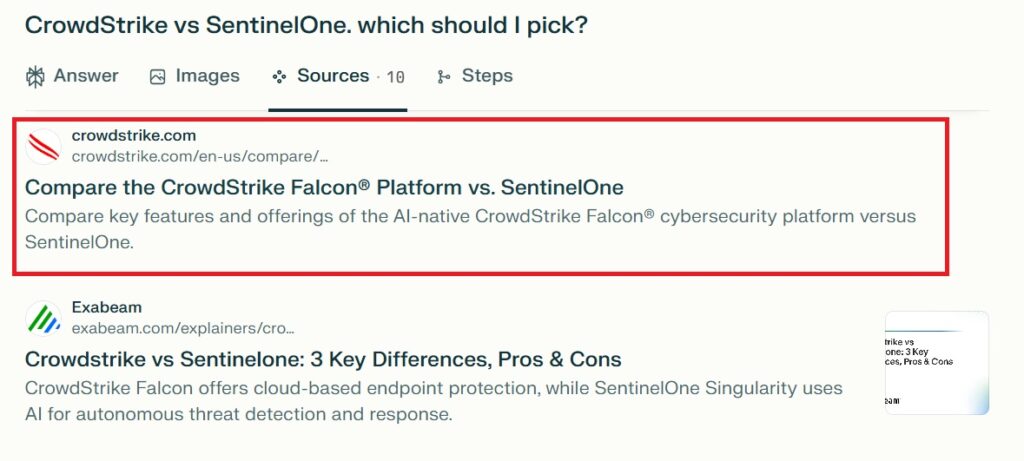
CrowdStrike Falcon appears as the top source in a comparison search on Perplexity
This isn’t about pumping out generic blogs. It’s about writing for the exact moment a buyer is choosing between vendors.
Takeaway:
If you don’t create content around the questions your buyers are already asking AI, you won’t appear in those answers. Start by listing the “what’s the best…,” “who are the top…,” and “X vs. Y” questions in your category. Then build pages that speak to them clearly.
#2 They Make Their Product Pages Buyer-Friendly
CrowdStrike’s solution and pricing pages don’t hide the ball. They’re clear, structured, and designed for decision-making.

CrowdStrike pricing page with clear plans and transparent details for buyers
AI systems reward pages that are transparent and easy to parse. A pricing page with actual numbers, feature comparisons, and clear CTAs is more likely to surface than one that buries details.
Takeaway:
Make your product and pricing pages as buyer-friendly as possible. Transparency reduces friction for humans and increases visibility in AI-generated results.
#3 They Get Referenced Outside Their Website
CrowdStrike doesn’t rely only on its own site. You’ll find them in analyst reports, review platforms and industry publications.
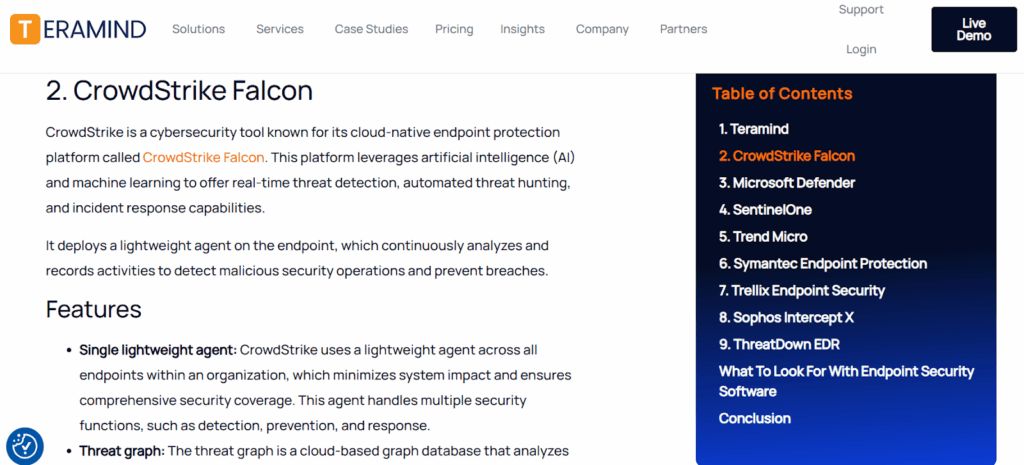
CrowdStrike referenced on third-party platforms, boosting credibility for AI
Why does this matter? AI tools weigh external mentions heavily. We’ve actually broken down where ChatGPT gets its information for SaaS recommendations.
If multiple trusted sources talk about your brand, AI is more confident in recommending you.
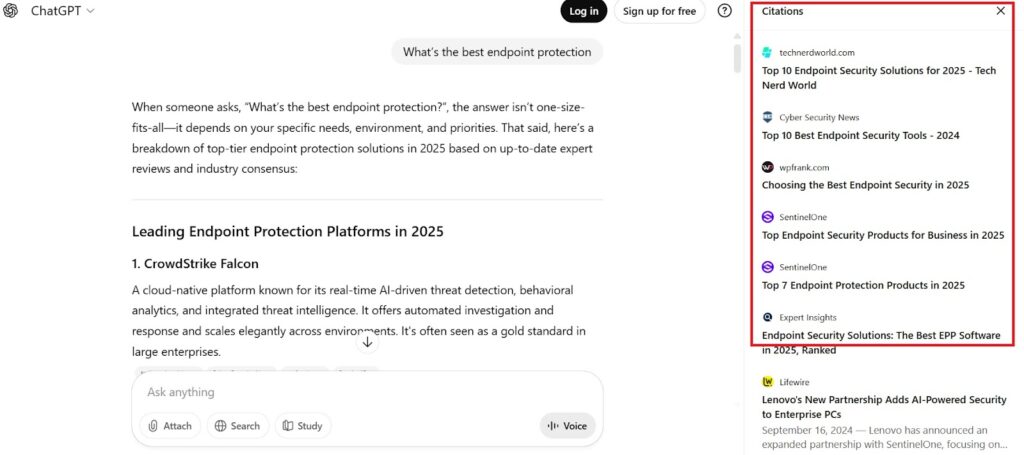
CrowdStrike cited across multiple sources in ChatGPT’s answer for best endpoint protection
Takeaway:
Invest in distribution. Guest articles, analyst coverage, customer stories and PR all boost your chances of showing up in AI answers.
#4 They Keep Their Content Fresh
Cybersecurity evolves fast and CrowdStrike’s content reflects that. Their resources are frequently updated with new threats, new product features, and current market context. For example, CrowdStrike 2025 Global Threat Report
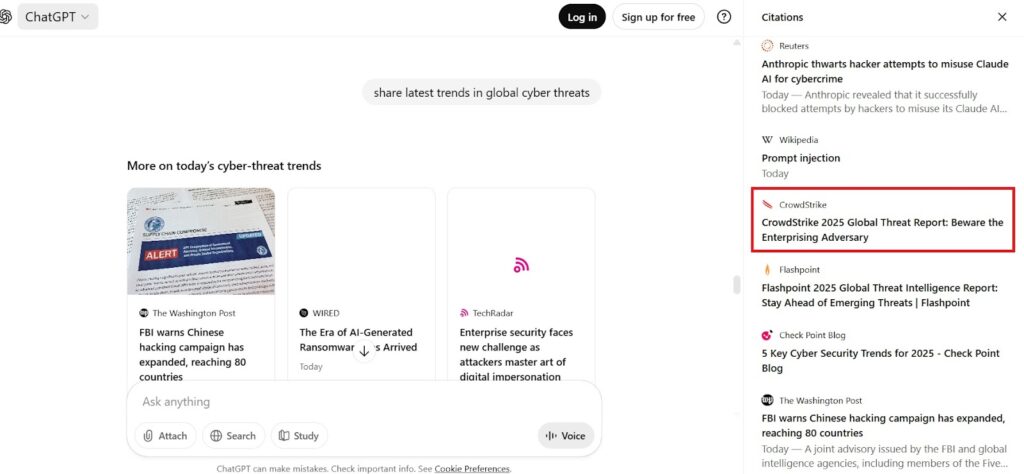
CrowdStrike 2025 Global Threat Report cited by ChatGPT for latest cyber-threat trends
AI systems tend to favor fresher, more relevant sources. Outdated content risks being ignored, even if it once ranked well.
Takeaway:
Don’t just publish. Update. Refresh old pages with current data, updated screenshots, and relevant messaging to stay in AI’s answer set.
#5 They Balance Depth with Simplicity
CrowdStrike knows how to talk about tough topics without making your head spin. They don’t strip away the details, but they also don’t drown you in jargon.
Take their Charlotte AI Agentic Workflows. On paper, it’s a pretty advanced setup with multi-step, AI-powered automation running behind the scenes. But when you look at the interface, it’s clean and easy to follow. Boxes, arrows, and clear labels show you exactly what’s happening without making it feel overwhelming.
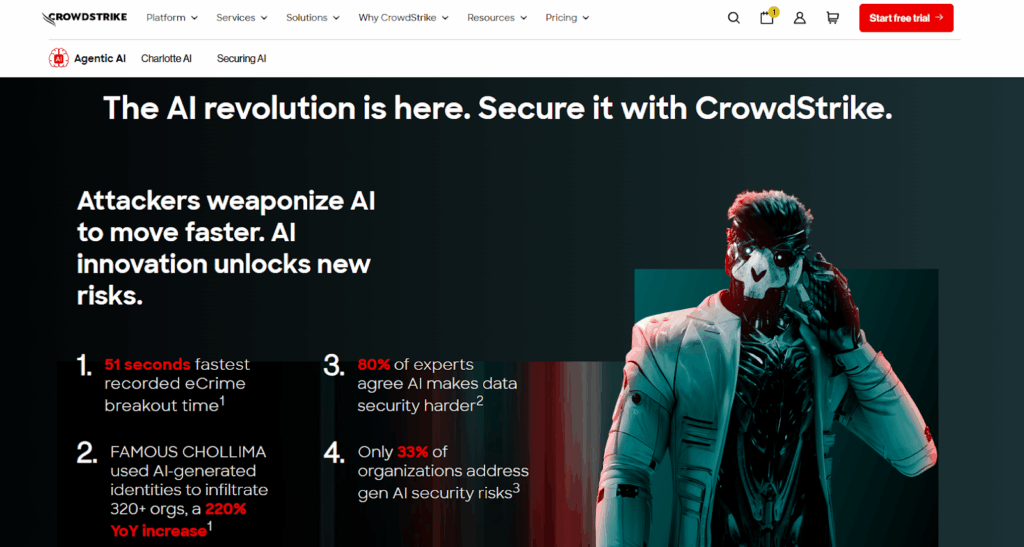
CrowdStrike’s page with bold, plain-English messaging and stats that make AI security risks easy to grasp
That balance is powerful. It’s what makes their content easy for AI systems to pick up and just as easy for a human buyer to trust.
Takeaway:
Don’t overcomplicate things. Go deep enough to prove you know your stuff, but package it in a way that’s clear and scannable. Simple visuals and straightforward language go a long way in making complex ideas stick.
Final Thoughts: Winning Visibility in AI Search
AI tools are quickly becoming the first place buyers turn to with high-intent questions.
CrowdStrike shows up in AI search results because they’ve aligned their content with buyer intent, built trust across the web, and kept their messaging sharp.
If you want a founder-friendly playbook, we’ve put together best practices to rank your brand higher in ChatGPT and other answer engines.
At Concurate, we help SaaS founders build that same kind of visibility through Generative Engine Optimization (GEO). From mapping the exact queries buyers ask AI tools to creating content assets that engines trust and cite, we make sure your product shows up when decisions are being made.
Our work has helped clients generate 24+ leads from just three blog posts, earn citations in AI-generated answers, and outperform even Google ads in the U.S. and U.K. markets. We understand that the rules of SEO and content are changing fast in the age of AI, and we’re adapting in real time.
With us, you get:
- A GEO visibility audit against competitors
- Content tailored to AI-powered queries (comparisons, alternatives, proof points)
- Authority-building signals that LLMs pull from
- Continuous monitoring to stay visible as AI search evolves
Curious how our approach could work for your SaaS? Let’s uncover the blind spots that might be holding you back and turn them into opportunities for growth.
FAQs
GEO is the process of making sure your company shows up when buyers ask AI tools like ChatGPT or Perplexity “what’s the best tool for X?” If you’re not mentioned in those answers, buyers may never even consider you.
They scan the web for patterns: clear product pages, credible comparisons, fresh content, and mentions on trusted sites (reviews, reports, media). If your content checks those boxes, you’re more likely to be pulled into AI-generated answers.
Yes. In fact, smaller SaaS often move faster. If you create the right proof points like comparisons, alternatives, customer stories, you can earn visibility in AI answers before larger competitors catch up.
Start with an audit: ask AI tools questions your buyers would ask (e.g., “best [your category] tools”). See if you show up. Then, create content that directly answers those questions and get your brand mentioned on third-party sites AI trusts.
A cybersecurity marketing agency specializes in helping security product and service providers stand out in a competitive market.
Unlike generic agencies, they understand the nuances of CISOs, IT directors, and compliance-driven buyers. They craft expert-driven content, thought leadership, and lead-generation campaigns tailored for the cybersecurity industry.
If you’re evaluating options, here’s a curated guide to the top cybersecurity marketing agencies of 2025.
Disclaimer
All product names, logos, and brands are the property of their respective owners. This profile is for identification, analysis, and benchmarking purposes only. Concurate is not affiliated with or endorsed by any featured company unless stated otherwise. The analysis is based on publicly available information as of the date noted. If you’re a representative and spot outdated or incorrect details, feel free to contact us for an update.


